From sign-up to “aha!" – the power of self-service onboarding
Discover how a self-service onboarding experience empowers users and fuels product adoption. Learn from leading SaaS companies to design an onboarding flow that helps users discover the platform independently and realize value faster.

Imagine a company's buying committee excitedly acquiring a new SaaS platform. It promises streamlined efficiency. Or perhaps, it will result in cost savings. Maybe it introduces a revolutionary approach to executing routine tasks.
But then the platform lands in the hands of those who will actually use the product and it gets reduced to an overwhelming maze of features.
There is a left sidebar menu, a top navigation menu, and tabs with (sometimes cryptic) one-word labels encapsulating capabilities. The user dives in, at first patiently, then with growing frustration, trying to decipher the various menu options, uncover features hidden behind ellipses, and understand the overall workflow.
When they get stuck they have to get in touch with customer service. They hope that a human will be on the other end of the phone or screen to guide them. This happens perhaps once, perhaps several times, perhaps just on day one, perhaps for an entire month!
This story plays out more often than you think with SaaS platforms.
According to OpenView Partners, the activation rate in best-in-class PLG companies is about 33%. This means that about a third of users who sign up for a product take an action indicating it benefits them.
So even for successful product-led companies, there's a large segment of users who haven't yet reached the 'aha!' moment – the point where they grasp the product's true potential and find value.
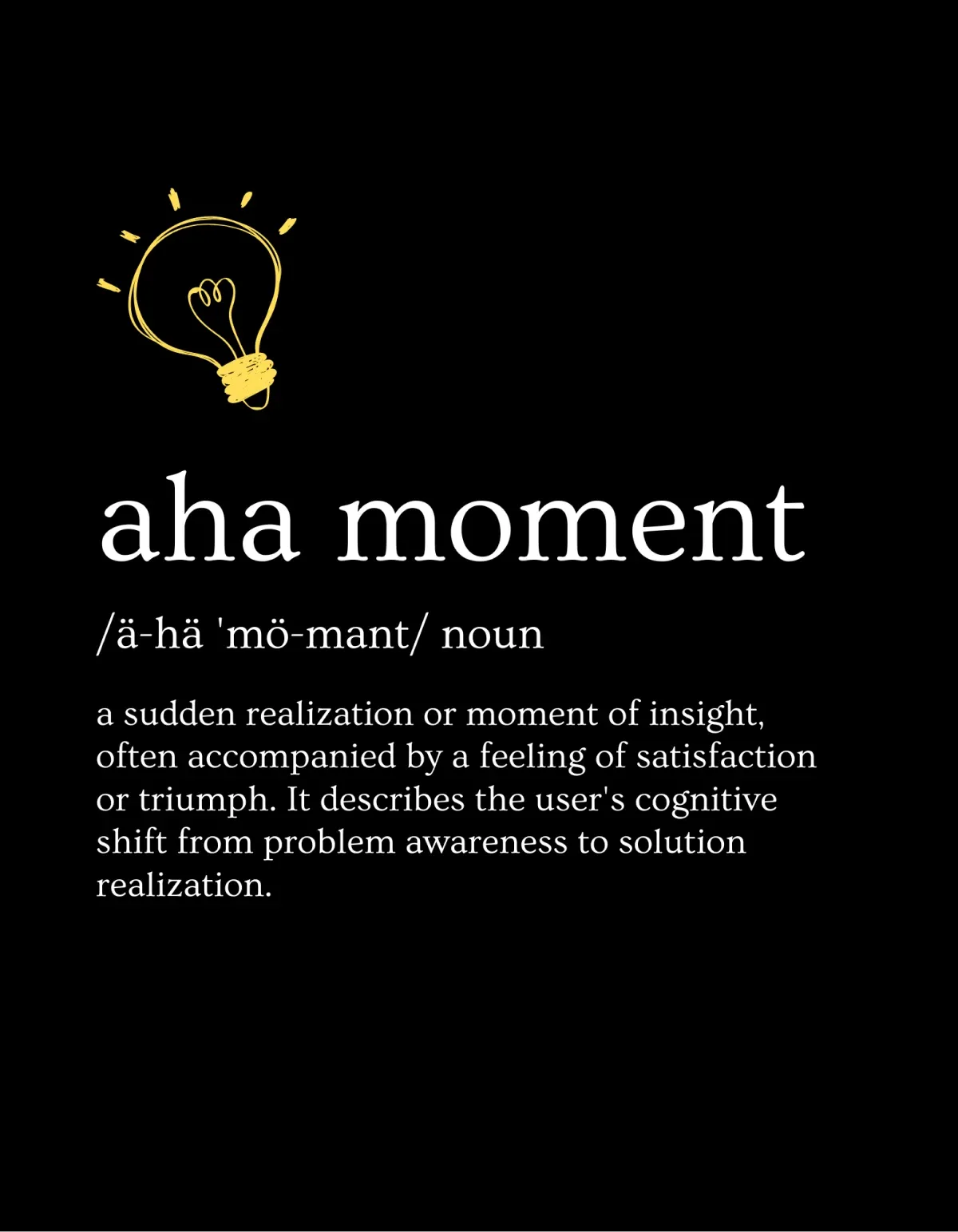
Self-service onboarding can help counter this. It empowers first-time users and drives them to the point of becoming power users.
The power of self-service onboarding
Self-service onboarding flips the script on traditional platform introductions. Instead of a rigid, predefined path, it allows users to navigate and learn about the platform independently.
It gives them control
New users might have specific workflows in mind, or they might discover unforeseen uses for your platform. Self-service onboarding allows users to explore features at their own pace, tailoring their discovery experience to their needs.
Think about it this way. You're planning a trip to Rome in three days and want to embrace the local culture. Would you rather spend hours memorizing the Italian alphabet, or hop online to learn key phrases like "hello," "water," and "thank you"?
The answer is obvious – focusing on practical phrases gets you results fast.
The same principle applies to SaaS onboarding. Instead of overwhelming every user with every feature, self-service onboarding lets users quickly learn the essentials – the "how-to's" of accomplishing tasks that are key to them – and start experiencing the product's value right away.
It builds user stickiness
By offering in-app tutorials, help center articles, and interactive demos, you can empower users to gain a deeper understanding of the platform's capabilities not just through passive instruction, but by actually trying things out and seeing the results.
Users who feel empowered to discover features on their own tend to be more engaged, fostering user "stickiness" - the tendency to keep using and coming back to the product.
If you’re going to learn a song on a guitar, you can memorize its chords from a sheet. But until you physically pick up your instrument and experiment, the melody won't come alive.
The same goes for SaaS platforms. Self-service onboarding offers a "playful discovery" environment, where users become more invested in mastering the platform, ultimately driving user retention.
It reduces reliance on customer success teams
Self-service onboarding leverages readily available resources eliminating the need for one-on-one onboarding with each user.
While it doesn't eliminate customer support, self-service onboarding reduces the burden on your customer support folks who are freed up to focus on more complex user issues.
How self-service onboarding compares to white-glove onboarding
Complex products tend to benefit from a white-glove onboarding experience. Here, a customer success representative guides the user experience with a structured program, ensuring users grasp the core functionalities.
However, even in such cases, allowing users to explore the platform independently after the initial setup can be valuable.
How self-service onboarding fuels the user journey
There's no denying that first impressions matter. With self-service onboarding you set the stage for the entire product experience.
Say a user is signing up for the first time. Offer them intuitive forms, progress bars, and contextual help – and the user starts warming to the product. They can already feel a sense of achievement.
Take the case of a new user signing up for a project management tool like Asana.
A well-designed self-service onboarding walks them through creating their first projects. Once they successfully complete these actions, they'll experience the platform's power to streamline their workflow firsthand.
The user experience doesn't end with the first use. Self-service onboarding can be a powerful tool for sustained engagement and user retention.
Imagine the same user from the project management example. As s/he continues using the tool, the onboarding experience can evolve, showcasing advanced features and suggesting best practices through contextual nudges within the platform.
Users won't remember everything in one sitting, nor should you try to cram everything in. The key is to think beyond the first experience and consider the entire user journey. What can you do to support returning users?
The essential elements of self-service onboarding
Here are some elements you can use for building your onboarding flow.
Signup form
The signup form is the very first time someone experiences your product and it can help them decide whether your platform is worth their valuable time.
- Keep the signup form streamlined: Focus on capturing only the essential information needed for account creation. Don't overwhelm users with unnecessary fields.
- Fight friction with SSO: Integrate single sign-on (SSO) options for a seamless experience. Leveraging existing login credentials saves users time.
- Data with a purpose: Collect strategic data that allows you to understand your user base. This data fuels user segmentation, targeted communication, and ultimately, helps you tailor your platform to the personas driving product adoption.
Welcome email
A well-crafted welcome email can make that first digital handshake impactful.
- Highlight the “wow" factors: Don't just say "Welcome!" Showcase the most exciting features and benefits of your platform. Spark their curiosity and get them eager to explore.
- Give a gentle nudge: Even if they've already started exploring, offer a clear next step. This can be a nudge towards a specific feature or a helpful tutorial.
- Make self learning easy: Point them towards readily available resources like help articles or pre-built templates. Empower them to learn at their own pace.

Contextual help resources
Imagine you're exploring a new city. Sure, a map is great, but wouldn't it be amazing to have friendly locals pop up and answer your questions right when you need them – like where’s the nearest cafe? Contextual help resources in self-service onboarding are exactly like those helpful locals.
- Knowledge base articles: Well-written, concise knowledge base articles provide in-depth information on specific features and functionalities.
- FAQs: Clear and comprehensive FAQs address common user questions, saving time and frustration.
- Video tutorials: Engaging video tutorials offer a visual, step-by-step approach to learning key platform features.
By offering a combination of these resources, you create a layered support system that caters to different learning styles.
Progress tracking and milestones
Let’s take the case of a new user signing up for a language-learning app. A progress bar showing their completed lessons and earned points gamifies the learning experience. Seeing their progress visually keeps them motivated and engaged, encouraging them to learn more.
- Boosts motivation: Visualizing progress provides a sense of accomplishment and fuels the desire to keep learning.
- Provides transparency: Users can see how far they've come and what's left to achieve, fostering a sense of control over their learning journey.
- Encourages goal setting: Milestones and progress bars can inspire users to set personal goals and track their achievements.
Think of milestones as virtual high-fives along the way. They mark key achievements and celebrate progress made.
- Rewards and recognition: Milestones can trigger rewards like badges or unlocking features – a fun way to acknowledge user progress.
- Breaking down the journey: Major milestones can serve as checkpoints, dividing the onboarding journey into manageable steps, reducing feelings of overwhelm.
- Increased confidence: Completing milestones provides a sense of accomplishment, boosting user confidence in their newfound skills.
Strategies for enhancing the self-service onboarding experience
Effective self-service onboarding strategies are important to transform hesitant users into confident explorers of your platform and drive user retention. Here are some ways to get started:
Determine the user’s path to success
- Map the user journey and behavior: The B J Fogg Behavior Model highlights the importance of motivation, ability, and trigger in driving adoption. You can use this to create a self-service onboarding flow based on how the user interacts with your product using triggers to encourage exploration.
- Prioritize core features: Focus on showcasing functionalities that directly contribute to the user experience. Don't overwhelm them with everything at once.
- Interactive guidance: Utilize in-app tutorials, tooltips, and walkthroughs to highlight key features within the UI/UX design itself.
Tailor onboarding to user roles and goals
- User role matters: Not all users are created equal. Identify different user roles and tailor onboarding content to address their specific workflows and goals.
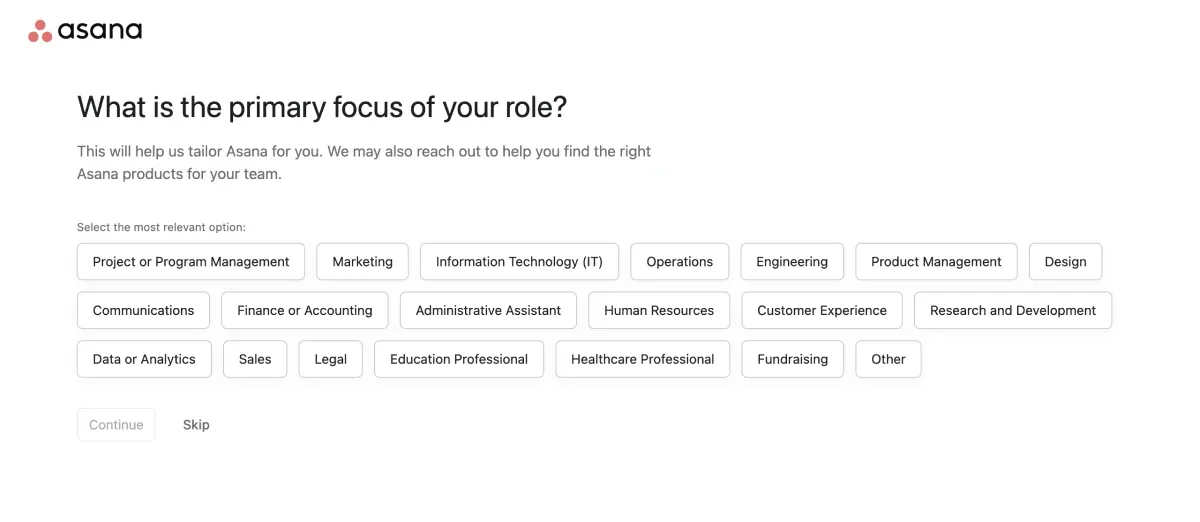
- Company size matters too: The needs of a small startup will differ from those of a large enterprise. Adapt your onboarding to cater to diverse company sizes.
- Signup goals as a compass: Leverage signup data to understand user intentions. Did they sign up to learn a specific skill, manage a team, or solve a particular problem? Tailor the onboarding journey to address those goals.
Provide a quick win
Don't leave users searching for value. Design your onboarding flow to deliver a "quick win" early on.
- Pre-populate templates: Offer pre-built templates or sample data relevant to the user's role or industry.
- Celebrate milestones: Acknowledge user progress with badges, personalized messages, or unlocking new features.
- Focus on actionable insights: Provide data visualizations or reports that showcase the value users are already deriving from the platform.
Use analytics to refine the self-service onboarding process
Self-service onboarding is a powerful tool, but how do you know it's truly working? That's where analytics comes in.
Metrics that matter
- Completion rates: This measures the percentage of users who complete the onboarding flow. A low completion rate might indicate confusing steps.
- Time spent in product: How long are users actively using the platform after onboarding? A significant drop-off could signal a disconnect between onboarding and the actual user experience.
- Feature adoption: Are users actively utilizing the core functionalities of your platform? Low adoption rates might indicate the onboarding process isn't effectively showcasing the product's value proposition.
- Activation rate: It reveals the percentage of users who sign up and then go on to experience the core benefits of your product. It's the gold standard of onboarding success.
A/B testing for continuous improvement
The beauty of data is that it empowers you to constantly improve. With A/B testing you can compare different versions of your onboarding elements, like tooltips or welcome emails. This helps you identify what kind of messaging or design resonates most with users, using which you can optimize the self-service onboarding flow.
Identifying friction points
By analyzing user data, you can pinpoint where users are getting lost or dropping off during the onboarding process. This could be a confusing signup form, an overwhelming interface, or a lack of clear guidance within the product.
Once you identify these "drop-off points," you can take action to improve them. Simplify the signup flow, provide better tooltips, or adjust the onboarding content to address those specific user struggles.
How leading SaaS platforms mastered self-service onboarding
Self-service onboarding is no longer a nicety – it's a necessity. Let's take a peek at how three industry leaders – Asana, Notion, and Canva – have mastered the art of guiding users to success.
Asana
Asana, the popular project management tool, understands that users crave immediate value. Their onboarding flow goes beyond simple introductions, providing value from the get-go.
- Role-based relevance: During onboarding, Asana gathers user role information. This allows them to tailor the experience by recommending Asana features most relevant to the user's specific needs (e.g., project manager vs. designer).
- Project creation as onboarding: Asana's onboarding flow cleverly integrates project creation. Users aren't just shown features - they're actively guided through creating their first project. This gives users a chance to experience the core functionalities right after signup – a great way to get the ball rolling and deliver immediate value.
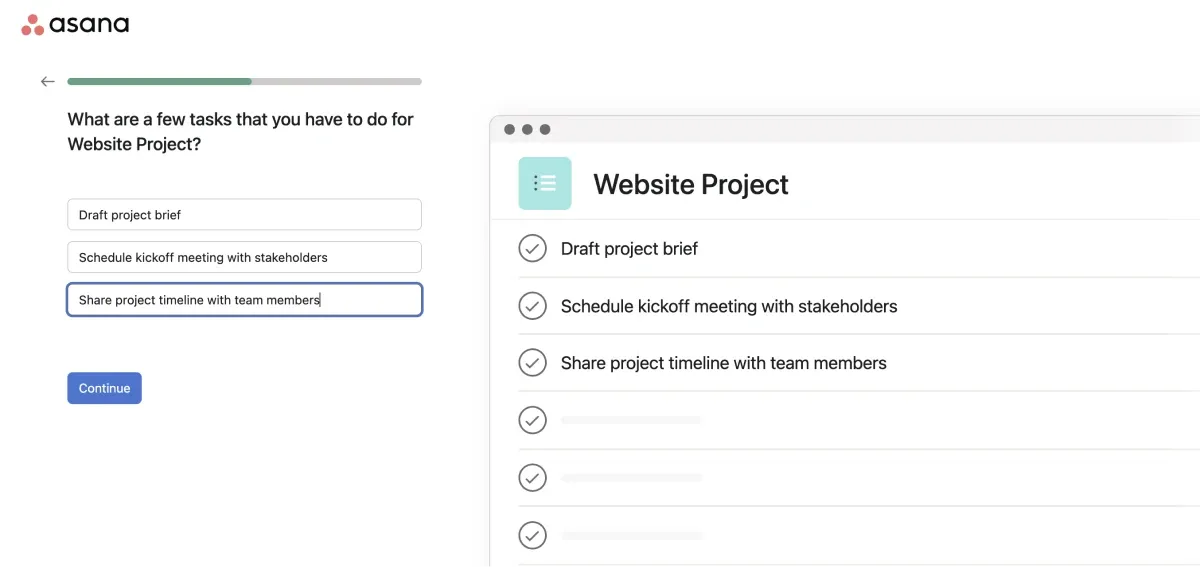
- Guided exploration with a checklist: New users land on their "project home" greeted by a strategic in-app checklist. These aren't overwhelming to-dos; they're bite-sized actions like "Try out portfolios" or "Customize your home."
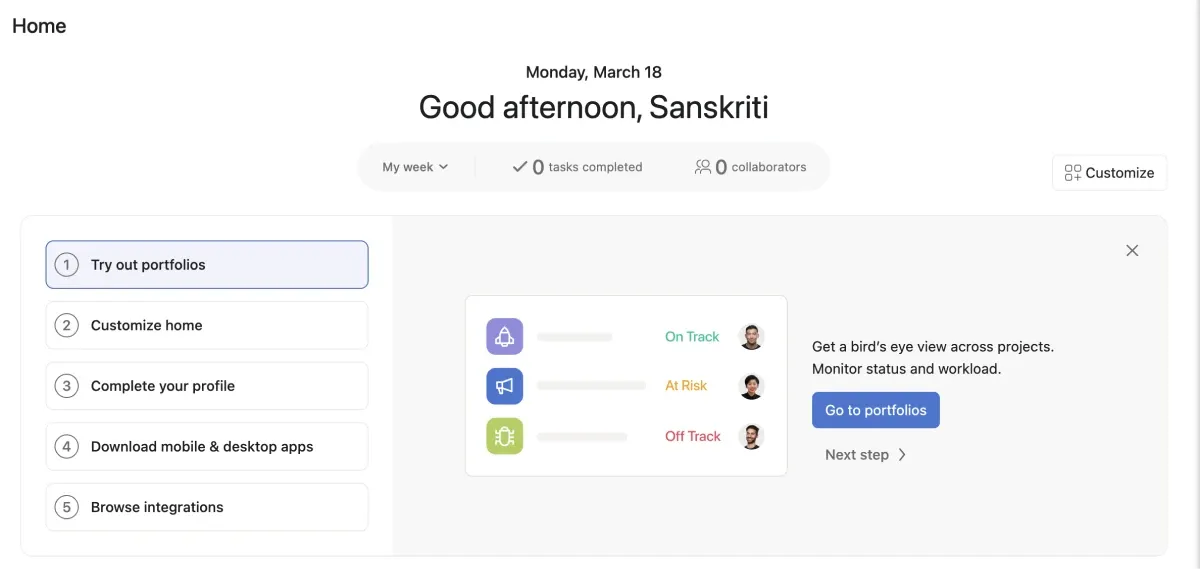
Notion
Notion, the all-in-one workspace, offers a blank canvas for creativity. Their onboarding focuses on empowering users to explore and personalize their experience.
- Contextual tooltips: Once users are "in” the platform, they're supported by minimally disruptive contextual tooltips. These concise explanations provide just-in-time learning, answering questions and smoothing the user journey without interrupting their workflow.
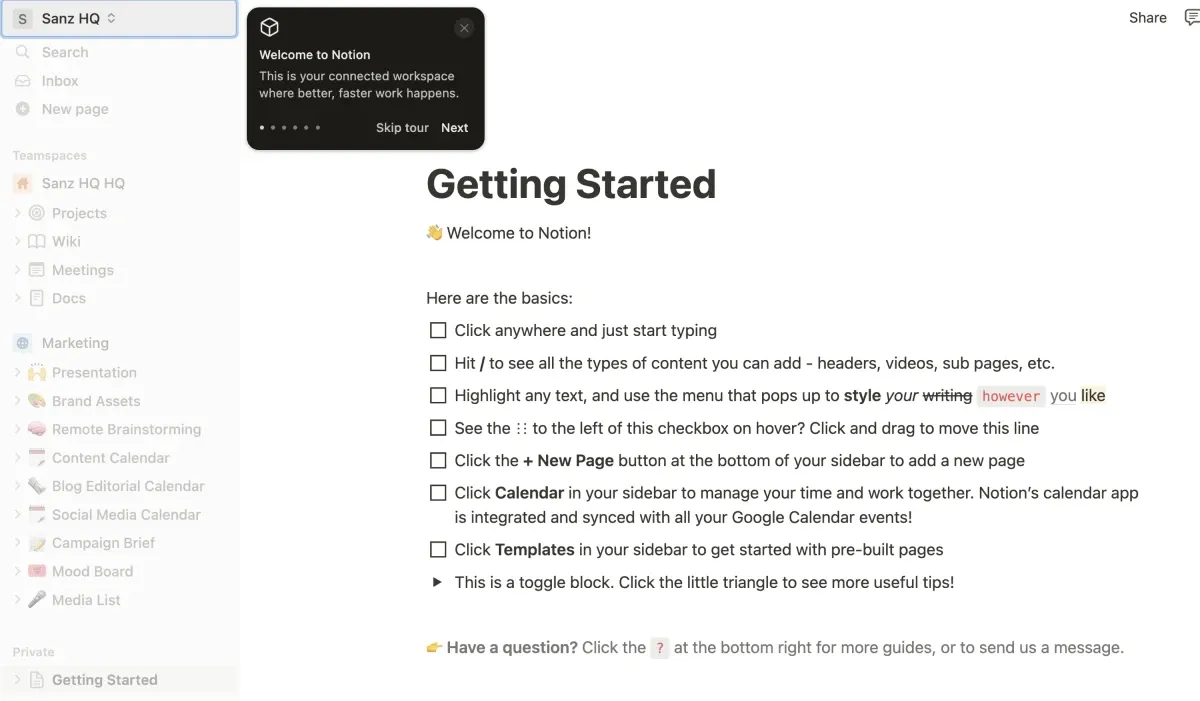
- Continuous learning: Notion's commitment to user empowerment extends far beyond the initial onboarding experience. They've created a vast library of resources that serve as a one-stop destination for ongoing learning and exploration.

Canva
Canva, the design powerhouse, understands the power of a visual approach.
- Personalized onboarding: During onboarding, Canva asks users about their intended use (small business, student, etc.). This allows them to recommend relevant design templates, tutorials, and learning materials tailored to the user's specific needs and goals.
- Pre-designed templates: Canva offers a large library of customizable templates like invitation templates, brochure templates, flyer templates, Twitter post templates, and many more for almost any design need.

By taking a page out of the playbooks of these SaaS leaders, you can create a self-service onboarding experience that empowers, engages, and ultimately delights your users.
Continuous learning is the key to helping users unlock value
Onboarding doesn't (and shouldn’t) end on day 1. By prioritizing continuous learning through self-service onboarding, you create an environment where users can discover value within your product over time.
A well-designed self-service onboarding journey isn't just about features – it's about user outcomes. It helps users unlock the full potential of your product, leading to greater satisfaction and achieving their desired results – whether that's becoming a more efficient professional or sleeping better at night.
